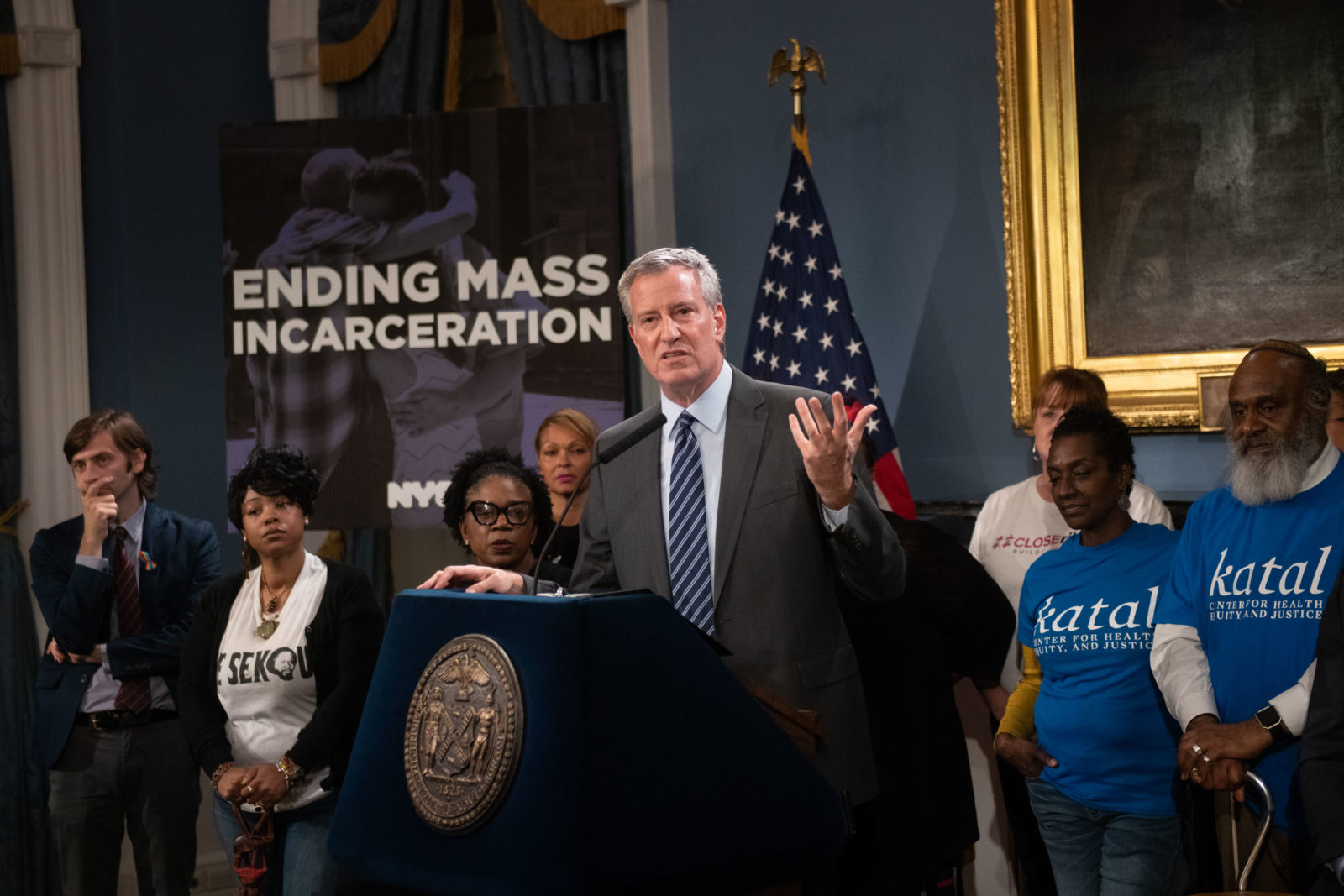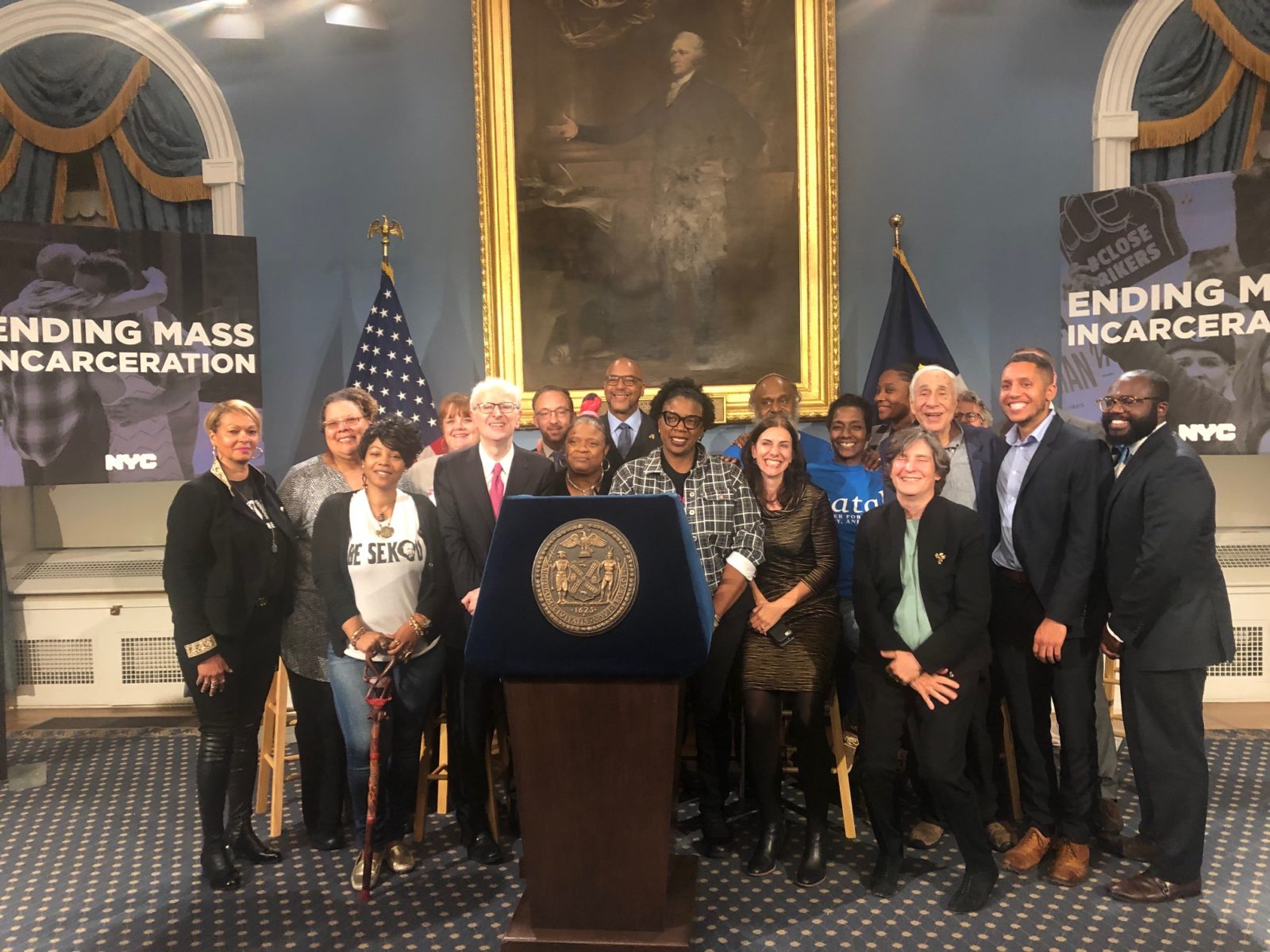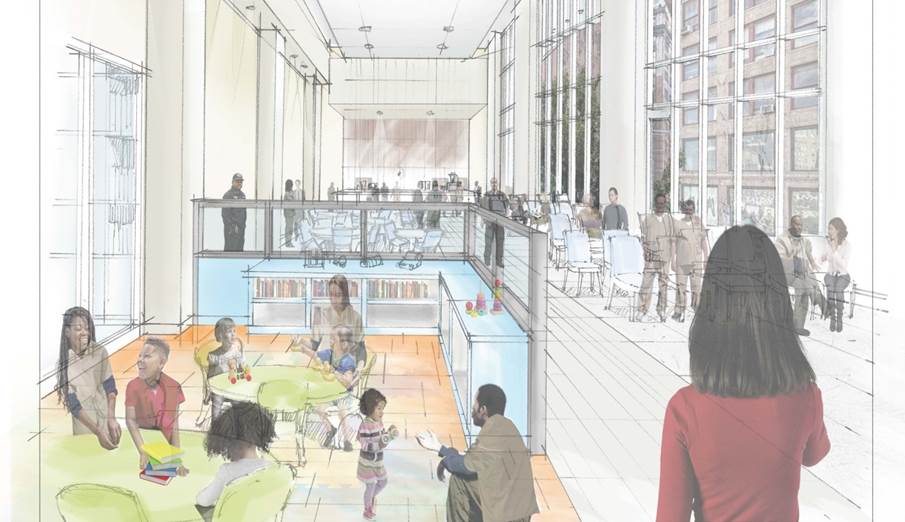2019 Year in Review
Turning Point
Slowly, then all of a sudden, New York City’s justice system has utterly reshaped itself. Over the last six years, with the work of many, the city has seen the fewest people in jail, the lowest crime rates and the lightest touch of enforcement since the 1950s. If that were all, it would be remarkable. But it’s not. Less storied has been the ground-shifting change in how we secure our safety while building thriving neighborhoods, mindful of hard lessons from our city’s history. Moving beyond the apparatus of the criminal justice system alone as the way to change behavior, we are taking a different approach, grounded in neighborhood connections. This civilianized approach uses different tools and decision makers. From revitalized public spaces to norm-changing vigils, and from federations of local non-profits to resident and city agency problem-solving convenings, this approach has produced measurable results. It is the new frontier of safety, established by each of us and all of us dedicated to making a peaceable and vibrant city.
Elizabeth Glazer, Director of the Mayor’s Office of Criminal Justice
Since 2014, the Mayor’s Action Plan for Neighborhood Safety (MAP) has brought together over 27,000 residents, city agencies, including the police department and non-profits in 15 neighborhoods to identify and solve problems together, ranging from youth engagement and workforce development to the quality of public spaces. The key driver of this effort is a regular, vibrant gathering of community members, city agencies, including the police department, and other local partners who sit together as equals to find systematic fixes for key neighborhood issues. This year, convenings took the form of interactive fairs that drew thousands of residents, young and old, to participate in setting priorities to improve safety and well-being, and to strengthen the quality of life for local residents.
Read the Brooklyn Daily Eagle story, “Tenants at Bushwick Houses brainstorm how to spend $30k on safety.”
Read our case study report on MAP that explores its origins, evolution, and initial impact of MAP.
Read more about the effectiveness of NeighborhoodStat from the Center for American Progress.
Read independent evaluations on the effectiveness of MAP from John Jay College.
Photos by The Center for Court Innovation.
A key component of improving well-being is revitalizing communal spaces. From Brownsville in Brooklyn to Claremont in the Bronx, communities worked together on 35 tangible projects, from lighting up streets and turning brick walls into canvasses, to bringing the night to life with creative programming. Conceived of and completed by development residents working with their MAP Engagement Coordinator, this ongoing effort has produced nearly three dozen reconceptions of physical space and social programming in public housing developments to promote greater safety, well-being, and cohesion.
Because every community deserves neighborhoods that are safe and vibrant, MAP developed Safe Places, Active Spaces: A Community Playbook for Transforming Public Spaces in Your Neighborhood. Safe Places, Active Spaces provides residents with a blueprint on how they can join their neighbors to improve community safety and well-being by activating the streets, parks, and public housing in their neighborhood.
Photos by Bronx Documentary Center/ Adi Talwar and Ed Alvarez.
Download Safe Places, Active Spaces here.
Read the Brooklyn Daily Eagle story, “Music program brings Bed-Stuy NYCHA development together.”
“A space is just a space until we turn it into a place.”
Founded in 2017, the Office to Prevent Gun Violence (OPGV) is a community-led approach to reducing gun violence. A central piece of OPGV’s work is the federation and support of the city’s Crisis Management System (CMS), which consists of 50 non-profits operating in 22 neighborhoods in which upwards of 50% of New York City’s shooting incidents occur. CMS engages with community partners to assist in mediating conflicts in the street, and preempt retaliation between individuals and groups. This successful approach is combined with sustained community engagement, including community-wide visibility each time a shooting happens, to demonstrate neighborhood solidarity and condemn the act of violence. In addition, employment programs, mental health assistance, and trauma services, among many others to support this effort. This approach has resulted in a 30% reduction in shootings over comparable neighborhoods.
This year, OPGV supported an array of new strategies to reduce violence. The Mayor’s Office and City Council responded to neighborhood demand by funding four new CMS locations, and expanding three other locations. In addition, new tools have amplified the work of CMS. Five new Mobile Trauma Units provide swift, coordinated responses to immediate crises by increasing access to trauma resources and maintaining a positive, stabilizing, and peaceful presence after incidents of violence.
Read the Brooklyn Daily Eagle story, “A revolutionary form of peace’: Anti-gun violence leaders kick off Peace Week.”
Read Patch’s story, “Ex-Gang Members, City Team Up to Stop Gun Violence In Fort Greene.”
The message of peace took to the air, through a partnership with iHeartRadio and Power 105.
“The co-production of safety in our communities can only be truly accomplished when it is designed to empower residents to lead the solutions to challenges.”
In April, OPGV launched Gun Violence Survivors Advisory Council, a group of mothers, fathers, and other family members who have lost loved ones to gun violence. This group plays a key role in facilitating and advising government agencies and community-based organizations on services available for families or victims of gun violence.
Meeting monthly, the Council discusses issues facing gun violence survivors, identifies gaps in existing services, and formulates recommendations to share with city agency partners and community-based organizations.
“We decided that now is the time for us to speak for ourselves and other survivors who have been directly impacted by gun violence.”
This year, the Mayor’s Action Plan for Neighborhood Safety (MAP) and the Office to Prevent Gun Violence (OPGV) have come together under one banner, the Office of Neighborhood Safety (ONS), to build on each other’s strengths and better serve the city’s neighborhoods. While OPGV is primarily focused on those who are at immediate risk for experiencing harm or perpetrating violence, the MAP team unifies thousands of primarily NYCHA residents, several city agencies, including the police department, to problem solve and address community-wide issues that perpetuate violence. For example, residents and community leaders at MAP developments will now have access to OPGV’s mobile trauma response units and tailored training on mobilizing for peace, while MAP staff and partners will help advise the operators of the Mobile Trauma Units on strategies to create welcoming, peaceful environments and events that facilitate community healing and connection.
Read the press release announcing the launch of ONS.
Photos by The Center for Court Innovation.
“The creation of the Office of Neighborhood Safety, with Eric Cumberbatch as its leader, displays wisdom and a long-term commitment to this directive.”

In September—months ahead of schedule—the City launched its Office for the Prevention of Hate Crimes (OPHC) to develop long-term, holistic strategies to prevent hate crimes, defined as personal attacks motivated by bias or prejudice. Deborah Lauter, a lifelong advocate in the fight against hate, joined the Administration as the new director of OPHC’s seven-person team.
OPHC oversaw the launch of new Neighborhood Safety Coalitions to offer communal healing and preventative programming in three specific Brooklyn neighborhoods, driven by the needs and goals of local residents and community organizations. On a wider level, OPHC coordinates the work of the Hate Violence Prevention Initiative (HVPI), 15 community-based organizations representing all five boroughs and the diversity of the City. HVPI addresses the prevalence of under-reporting among vulnerable communities and ensures culturally competent responses and victim services.
Read the New York Times profile of OPHC Director Lauter.
Read the Jewish Telegraphic Agency story, “She has 6 employees and less than $2 million. The mission: Stop anti-Semitism in New York City.”
“In New York City, we cherish our differences and reject all attempts to divide – everyone is respected and supported, regardless of their race, religion, sexual orientation or any other quality that makes them who they are.”
The Office of Special Enforcement (OSE) is a multi-agency task force charged with tackling illegal short-term rentals in order to preserve the City’s housing stock for permanent residents, and keep residents and guests safe.
OSE launched the “Stay in the Know” awareness campaign, educating the public about illegal short-term rental laws and how those laws protect New York City neighborhoods.
The office also made significant strides in obtaining critical data directly from online rental platforms. Additionally, OSE filed six important lawsuits, including litigation against a network of real estate professionals who used 130 apartments to unlawfully earn $20 million over three years, landlords who harassed tenants in rent-stabilized buildings, and against a company that converted manufacturing spaces into unsafe, illegal rentals.
Read The New York Times story, “Inside the Rise and Fall of a Multimillion-Dollar Airbnb Scheme.”
Read the Queens Daily Eagle story, “Mayor’s Office files lawsuit against alleged $5m illegal hotel operation.”
Visit nyc.gov/ose to learn more about the Mayor’s Office of Special Enforcement.
“Illegal hotels are dangerous and further diminish New York City’s already-scarce housing supply. I’m glad that the Office of Special Enforcement is being proactive in targeting bad actors.”
The City, in agreement with widespread community calls to action, made the decision to build new facilities, closer to courthouses and families within the four boroughs.
The reductions in the city’s jail population, driven by the work of many (see below), is the plan’s foundation. Both the biggest criminal justice reform effort and the biggest public works project the city has seen in more than a generation, its implementation is multi-faceted. Efforts to safely reduce the jail population and change culture inside the jails must continue as the city moves forward to build safe and humane local facilities.


A landmark step in that process occurred on October 16, 2019 when the New York City Council overwhelmingly passed the Mayor’s land use plan permitting the building of the new facilities. The approved plan will bring four modern jail facilities to the Bronx, Manhattan, Brooklyn, and Queens. With a target jail population of 3,300, the new facilities will be smaller, designed to integrate into neighborhoods, and focused on providing an array of services and programs. Physical space inside will be designed to produce better, safer outcomes for all those working, visiting and detained in them.
Learn more about the status of the Borough-Based Jails plan.
“Smaller, more humane jails located in close proximity to the courts are significant building blocks in the effort to overhaul the criminal injustice system.”
Read The New York Times editorial board column, “How to Close Rikers Island.”
Read The New York Times story, “After Rikers Island Closes, What Will Jail Look Like?”
Read The New York Times story, “New York’s Jails Are Failing. Is the Answer 3,600 Miles Away?”

To ensure Rikers Island is never again used to incarcerate people, the Mayor and City Council Speaker Corey Johnson are actively moving forward with a new land use proposal to permanently ban jails on Rikers by 2026. The City commits to launching a participatory planning effort this year through which New Yorkers will help formulate a vision for the future of Rikers Island.
Read about the new land use proposal that will ban jails on Rikers by 2026.
Read the Curbed New York story, “NYC begins process to ban jails from Rikers Island.”
In December 2019, the New York City jail population fell below 6,000 for the first time in decades, a decline of more than 70% since its peak in May 1991. This jail population decline took place alongside reductions in crime, giving New York City the lowest rate of incarceration and lowest crime rate of any large city in the United States. The hard work of the police department, buttressed by the co-production of community safety by New Yorkers through programs like MAP and OPGV, pretrial diversion programs such as supervised release, and increased alternatives to incarceration programs to replace city jail sentences, have helped keep New York City the safest large city in the nation.
See how the City projects a jail population of no more than 3,300 by 2026.

In the 2019 legislative session, New York State passed a host of legislative reforms to the criminal justice system, including bail reform and changes to discovery/speedy trial laws. The Mayor’s Office formed the Criminal Justice Implementation Task Force (CJRITF) to help coordinate between city agencies, the courts, district attorneys, and defenders on implementation of the new laws. In conjunction, the City allocated $75 million to city agencies, district attorneys, and public defenders to support this implementation.
To prepare effectively for state bail reform in particular, the City invested $116 million annually in expanded Supervised Release programs to help those released return to court and create connections to community-based services. The Manhattan District Attorney’s Office is providing $100 million over the course of the next two years, which is included in the annual total.
“Supervised release expands the City’s ongoing commitment to our pre-trial population that helps ensure their return to court, while helping clients make and keep connections to supportive services in their community.”
Read the Wall Street Journal story, “New York City Plans Support Network for Defendants Freed Under New Bail Laws.”
Read The New York Times story, “Jail or Bail? There’s a New Option.”
Listen and read to WNYC’s reports on the City’s efforts ahead of bail implementation.
On January 1, 2020, State bail reform legislation went into effect. In anticipation, the City made sure those leaving jail facilities were best prepared to return to their communities.
Working with our Jails to Jobs, Crisis Management System, and other partners, former detainees were met upon release, provided a bag of essentials that included things like toiletries and transit passes, and provided assistance connecting with social services to address medical, housing, and other critical needs.
View the brochure created alongside DOC and other city partners to assist people leaving jail make sure they have all the necessary information to facilitate an easier return to community.
The City is investing approximately $40 million annually in non-profit providers to help people discharged from custody transition back to their neighborhoods. This takes the form of community peers and other social supports, connecting people with training and transitional employment opportunities, as well as providing essential supplies, such as hygiene kits, MetroCards, food, and clothing vouchers.
Watch NY1’s report on re-entry support ahead of bail reform.
In 2017, New York State embarked on a new era of juvenile justice reform when it passed “Raise the Age” legislation to stop 16- and 17-year-olds from being automatically prosecuted as adults. On October 1st, 2019, the law became fully effective. The Mayor’s Office has continued to work with city agencies, the Courts, defenders, district attorneys, advocates and labor to assess the implementation of the law and track progress.
Read our report on the full implementation of Raise the Age.
“I will never forget the feeling of arriving to Rikers Island at the age of 16. It’s an experience no one should have, especially not a child. In implementing RTA, New York City and State took a long overdue step toward ending the criminalization of youth.”


